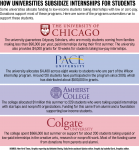UCLA may claim it’s committed to ensuring that its students start their careers with internship experience, but it’s fallen short in supporting students as they enter the job market.
The university has failed to keep up with other institutions of comparable prestige when it comes to subsidizing internships for its students. Unlike the University of Chicago and Pace University, UCLA’s Career Center does not provide grants or stipends for students who complete internships. Without that financial assistance, disadvantaged students may need to forgo unpaid or low-paying internships to work a higher-paying job, such as a barista or cashier positions.
Such jobs may help these students make ends meet, but they don’t look as good on a resume as an internship would. UCLA should subsidize internships for low-income, minority students so they can afford to pursue those career-building opportunities.
The Career Center’s failure to subsidize internships seems like even more of a blunder when long-standing racial inequities in science, technology, engineering and math fields are taken into account. The share of African-American and Hispanic students employed in STEM has been consistently low over a period of several decades, according to a 2013 Census Bureau report. Dr. J. Marshall Shepherd, a meteorologist and professor at the University of Georgia, noted in an Ebony magazine article that marginalized communities may miss out on job opportunities in a field that, according to a report from the Georgetown Public Policy Institute, is projected to outpace every other sector of the American economy.
The university must follow through on its commitment to diversity and inclusion, and on its promise to mold UCLA students into competitive job market candidates. A Career Center internship subsidy program can reduce race-based disparities in STEM hiring by helping minority students from low-income backgrounds pursue career-building internships.
Subsidizing internships can help break down a formidable financial barrier to greater minority participation in science and technology. A study released by the American Council on Education found that low-income minority students are less likely to complete their STEM degrees if they do not receive some sort of financial aid. Additionally, the study asserted that minority students who work more than 15 hours per week are also less likely to complete their degrees. Internships are essential to career development in STEM fields, and providing internship grants could allow such students to build their resumes through paid and unpaid internships without needing to work another job to make ends meet.
Many marginalized students have little contact with science and technology professionals, and internships can improve their career opportunities and expand their professional networks. In fact, Trey Moore, a National Weather Service meteorologist quoted in one of Shepherd’s articles, said minority students who lack connections with STEM professionals may be less likely to see a career in science and technology as a viable option. Advocacy groups like the National Action Council for Minorities in Engineering have also asserted that providing internships to a greater number of minority STEM students helps them network more effectively in their chosen fields.
Not everyone will support subsidizing STEM internships, however. Many students may balk at the cost of such a program, asserting that UCLA’s budgetary priorities cannot accommodate university-provided STEM internship grants. However, the university’s Centennial Campaign provides a model for the sort of endowment fund needed to establish and maintain such a program.
Launched in 2014 to mark UCLA’s upcoming centennial, the campaign seeks to “open doors” for UCLA students by funding scholarships and financial aid programs. Its focus on private philanthropy and aid to disadvantaged students can be replicated in a parallel endowment fund established to subsidize STEM internships. In fact, the University of Chicago already funds its Metcalf Internship program in this way, using university endowments and private donations to subsidize student internships. Following that institution’s lead should alleviate legitimate concerns about the financial viability of an internship subsidy program at UCLA.
In addition, some may criticize an internship grant program by pointing to the variety of ways in which UCLA already provides financial aid to disadvantaged students. However, existing financial aid programs do not provide sufficient support for students to pursue career-advancing internships. Specifically, a good number of students on financial aid have to complete work-study programs, and that time commitment may prevent them from doing internships. In addition, the university’s financial aid programs are largely designed to help students pay for tuition, not improve their career prospects.
Ricardo Vazquez of the UCLA Media Relations office noted that UCLA does not currently have any internship subsidy programs. However, he said the university would consider implementing such a program to improve diversity and inclusion at UCLA.
The lack of a STEM internship subsidy program suggests UCLA has not fully considered the barriers low-income minority students face in entering those fields. The university needs to create such a program to prepare all of its students for the job market and help remedy longstanding racial inequities in science and technology hiring.
If the university aims to build students’ futures, it should start by helping them build their careers.

No. UCLA is not going to start paying interns. The answer is no.
There is nothing stopping UCLA students from obtaining paid internships. The best way to correct the inequity that is lack of money in your bank account is to get a job. A paid internship provides a paycheck, along with valuable work experience.
But expecting the California taxpayer to subsidize every aspect of your existence, including awarding eligible students the full Cal Grant, is a non-starter.